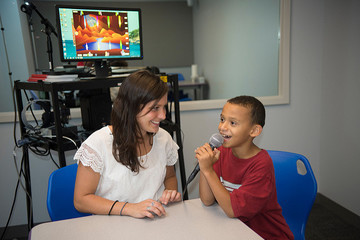
10/24/2017
Current students and faculty — and certainly employers — have known for years the strength of SUNY Cortland’s Communication Disorders and Sciences Department.
Now, a company created to help young people find good careers is letting prospective students know that the department is the No. 2 program of its kind in New York state.
Zippia.com used data from the National Center for Education Statistics and the Department of Education to evaluate communication disorders programs by career results, the number of each college’s majors in the field and a variety of factors including admissions rate, graduation rate, average cost of attendance and median amount of debt.
In the end, SUNY Cortland — which offers experienced faculty, opportunities for hands-on training and research and modern facilities — came in second only to the University of Buffalo, a university center more than three times the size of SUNY Cortland.
“The program has a really good reputation in the area, from Binghamton to Syracuse and from Cortland to Ithaca,” said department chair Ann Blanton. “It has a reputation for turning out well-prepared master’s students. It is a profession that is in high demand because it covers such an extensive range of the population. Literally from birth to end-of-life care.”
Undergraduate students may pursue either a major or minor in speech and hearing science. SUNY Cortland’s Master’s program in communication disorders and sciences has produced successful graduates since it welcomed its first class of students in 2013. The classes of 2013-15 and 2014-16 both had 100 percent employment rates and both had 100 percent Praxis speech-language pathology exam pass rates.
The interest from students in the field is growing because those who work in communication disorders are in demand from all angles of the medical profession. Not only are graduates working with children who have issues speaking or swallowing, they’re working with veterans who have suffered neurological problems, car accident victims and people living with progressive neurological diseases such as Parkinson’s or multiple sclerosis, Blanton explained. Communication Disorders and Sciences students play a vital role in today’s medical landscape and are pushed to look beyond their specialty and understand how their work intersects that of doctors, neurologists and physical therapists.
“It’s a vast profession,” Blanton said. “The opportunities to work in the profession are huge, from schools and private practice to rehabilitation clinics and acute care in hospitals. That is the foundation of these professionals being in such demand, it covers so much. To develop a program that ranks highly in covering all that information is quite an extraordinary thing.”
SUNY Cortland students are able to participate in many hands-on learning experiences during their studies. The department is heavily involved with local school districts to provide speech and hearing screenings. Students work with residents in local assisted living homes and traumatic brain injury patients. They also have opportunities for inter-professional education with the College’s physical education faculty.
“Rather than working in a silo, working with only speech pathologists, our students are taught as part of their program to work with students in physical education as well as physical therapists and teachers,” Blanton said. “They are given a wonderful exposure to other professions who are working with the same population.”
Blanton, who joined the faculty in August, points to Associate Professor Regina Grantham, the former chair, for her leadership in building the department.
“None of this is to my credit,” Blanton said. “I have nothing to do with the excellence of this program. I’m just fortunate enough to step into it. The architect of all this is Regina Grantham, her faculty and the administration of the College that has been very strongly supporting this program.”
For more information, visit Communication Disorders and Sciences online.